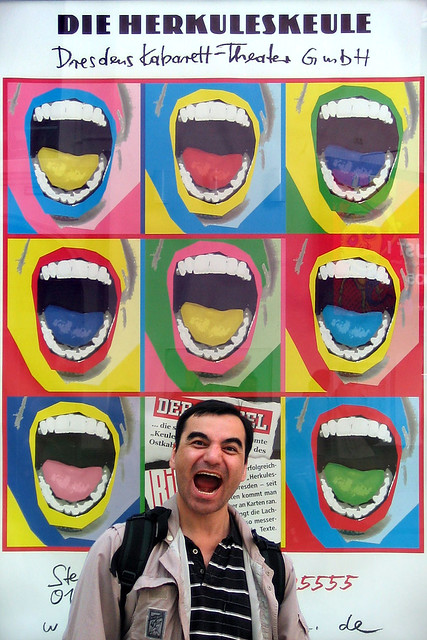
Poster near Dresden Hauptbahnhof
[ < < previous | index | next >> ]
A digression on food. We noticed something odd at the Kartoffel Keller in Berlin the other night. They had what appeared to be a specials menu, which was labelled Spargelkarte, containing about a dozen dishes all featuring Spargel. When we checked the English translations it turned out Spargel was asparagus, so they had a whole special section full of asparagus dishes. Then, when we went out here in Dresden last night, we checked the menus of several restaurants and every single one had a special Spargel menu as well. They read variously with items like Spargel Hollandaise, Spargel with potatoes, Potato and Spargel pancakes, Spargel Soup, Spargel and potato soup, Spargel with schnitzel, Spargel with sausage and sauerkraut, Spargel omelette, pork fillets with two types of Spargel, etc. The place we stopped at for dinner naturally had such a Spargel menu too, and the last item was Spargel and strawberries, with orange and lemon sauce. One surmises that it's currently Spargel season here in Germany, and everyone has Spargel coming out their ears, and wants to get rid of it any way they can.
 Poster near Dresden Hauptbahnhof |
Digressing further, the breakfast buffet here at Hotel Kipping is superior to the one at the place next to Arte Luise Kunsthotel in Berlin. The muesli still has chocolate in it, but also sultanas and dried banana. The fruit salad here is better - more variety of fruit. The boiled eggs here come in individual Mork and Mindy style plastic eggs in a range of funky decorator colours (insulated inside with styrofoam). Instead of dodgy chicken sausages there were little meatballs, spicy, with a centre of a piquant tomato sauce. The bread here came pre-sliced, in a greater variety. The cheese and meat selection was bigger. And they had a fruit torte - plum with a crumble topping - it was delicious.
I'm just reading from an information sheet about the history of the Hotel Kipping, in which we are staying. The building was commissioned in 1884 and built in neo-Renaissance style. It was used as a private residence by the Haymann family until 1898, when the two upper floors were converted into a boarding house for young women. From 1911 to 1920, the building served as accommodation as the Pension Minerva. Alfred Kipping, the present owner's grandfather, bought the building in 1932. During World War II, he moved the family business, a textile manufacturer, specifically of baby clothes and cloth nappies, into two floors of the building. On 13 February, 1945, when 90% of the surrounding buildings in the Schweizer Verteil (Swiss Quarter) of Dresden were destroyed by Allied bombing, the building survived unharmed and served as a shelter and place of safety for terrified neighbourhood residents. In 1972, the East German government nationalised the Kipping textile business, continuing production in the building. The Kipping brothers regained control in 1990 after reunification, but the business soon foundered. They decided to turn the building into a hotel and restaurant, opening the doors in March, 1994. Soon afterwards, the building was declared a significant historical landmark of Dresden and put under a preservation order.
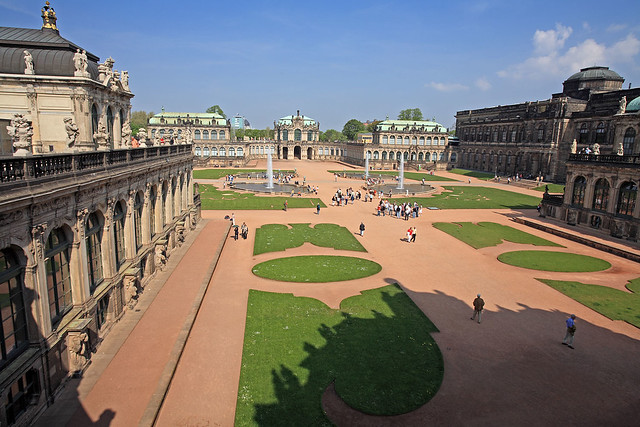 Zwinger courtyard |
We've spent much of the day absorbing history in various forms. After breakfast we walked back up Pragerstraße and thence to the riverside of the Elbe for a sweeping view across the north of Dresden. We walked over to the Theaterplatz and went inside the Zwinger, a large courtyard with fountains and formally laid-out lawns and stone paths enclosed by magnificent old stone buildings.
The Zwinger was built as an entertainment court for the royal family of Saxony, but now contains a bunch of museums. We first went into the Sculpture Museum, which was quite small. We bought a combo day pass ticket, which granted entry into all the other museums too, for €12 each. I also got a photography permit for €5, authorising me to take photos in all the museums. Wandering among the sculptures, we were questioned by a friendly staff woman in halting half-English, who seemed to have the impression that English was our second language too. She tried to tell us it was okay to use flash to take photos, while I tried to tell her in German that I didn't even have a flash. She wanted to know if we learned English at school, or how I knew a bit of German, or something, I'm not sure what. I sort of replied that I learnt some German from a book, and she said that's how she picked up some English too. Then she asked what language I learnt at school. I said Italian (picking one of the three I studied very briefly in year 7). And then she seemed to think we were Italian. Finally I said we were from Australia and spoke English. Then she wanted to know what language people learnt at school in Australia. It was all a very confusing conversation, so I added to it by giving an example of Japanese, which made her eyes light up in amazement.
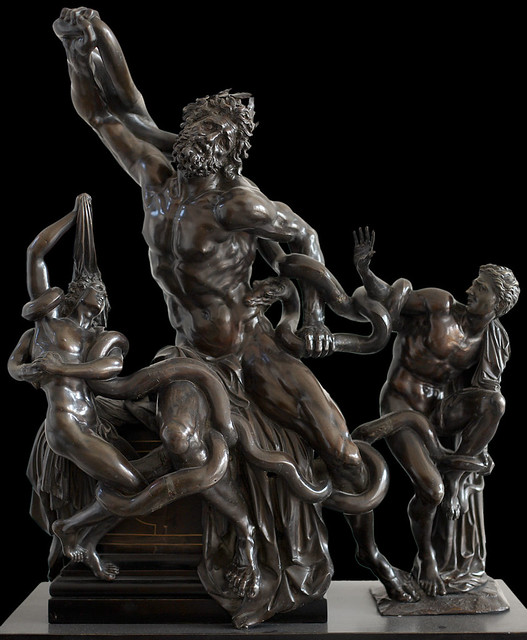 Sculpture in the Sculpture Museum |
From the Sculpture Museum, we walked about the Zwinger anticlockwise to a staircase leading up to the rooftop, which commanded a grand view of the courtyard below. The rooftop access led most of the way around the courtyard, so we followed it. We discovered the Physics and Mathematics Museum partway around, its entrance at this roof level, but to my great dismay it was closed for renovations, so we didn't get to see any of the collections and displays of antique scientific instruments and globes. :-( Disappointed, we continued nonetheless.
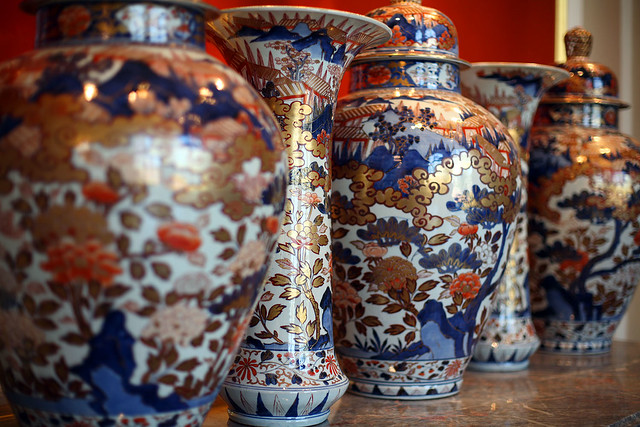 Porcelain Museum |
The next museum we came across was the Porcelain Museum, home to a vast collection of both imported Chinese and Japanese porcelain and locally made Dresden Meissen porcelain, which began as a local version making copies and works in the style of the Chinese imports, but has since grown to become famous for fine porcelain in its own right. The collection extended over about a quarter of the Zwinger, occupying several enormous rooms on the ground floor and some more upstairs. The Chinese porcelain came mostly in the form of large jars and smaller vases, as well as plates, all intricately decorated with coloured glazes either depicting Chinese scenes or abstract patterns, and arranged in symmetrical sconces on the walls. The Dresden porcelain began as obvious imitations of the Chinese imports, but soon developed a style of its own, adapting to European scenes and developing into amazingly detailed sculptures of the delicate material. A whole room was full of large white porcelain animal sculptures, many of them fanciful renderings of African or Asian animals with which the sculptor had been unfamiliar except by paintings or verbal descriptions. Apparently these pieces were the first attempts to create porcelain works so large, and new firing techniques had to be invented to successfully fire them without cracking or destroying them. In the end, they were left uncoloured, as the makers didn't want to risk a second firing to set coloured glaze on top of the white.
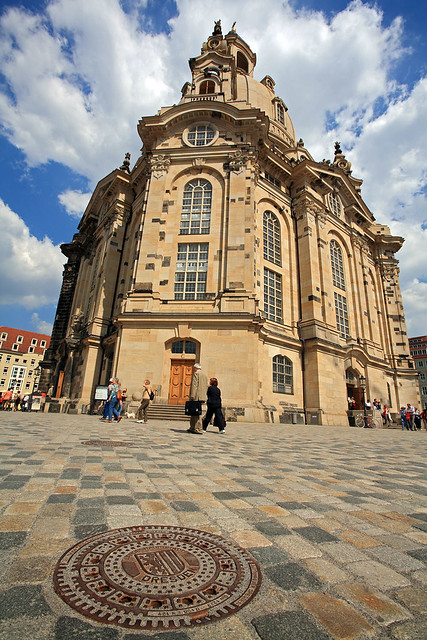 Frauenkirche exterior |
Being somewhat museumed out for the morning, we took a break for a lunch of sandwiches bought at a nearby bakery over in the Altstadt shopping district. We also bought pretzels for a later snack, cheese for me and a seedy one for Michelle. Then we walked over to the Frauenkirche, newly completed in its reconstruction after being almost completely destroyed in the war. We could see the difference in the colour of the sandstone, with age blackened stone from the early 1700s showing the small part of the church that was left standing and new clean stone betraying the 90-odd percent of the building that has been rebuilt since 1992. We joined a queue to get into the church after hearing a guide say it would be about 10 minutes' wait. The doors opened precisely at 13:00 after we had been standing in the searing hot sun, shielded by me holding my jacket over our heads. We realised then that it had probably been closed for lunch, as they were letting everyone in willy-nilly, not in limited numbers for tours.
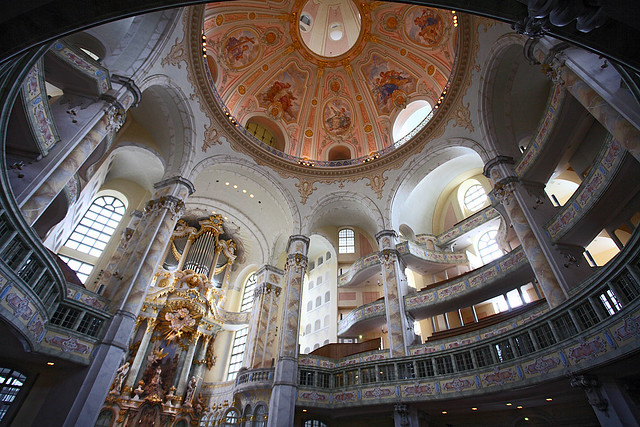 Frauenkirche interior |
We entered the blissfully cool interior and were blown away by the pastel-shaded paintwork on the intricate architecture, with four levels of balconies lining the sides of a vast chamber that soared aloft to the great bell-shaped stone dome above, painted with fresh bright scenes of angels and cherubim. We decided to head quickly down to the crypt beneath the church, which was open to all comers. It was even cooler down there, with new sandstone lining a central chamber that led into several side rooms containing some of the original stonework, tiny passages, vaults, and various crypts. Although a sign outside the church had said no photography, lots of people were taking photos and staff were ignoring them, so I sneaked a few myself. Returning to the church above, it was almost full of people milling about admiring the views, as well as mostly occupied pews of people sitting and soaking it all in. Dozens of people were snapping away, so I said, "blow it," and took a bunch of photos too.
Leaving the church, we went around to another entrance that promised access to the roof atop the dome, which would have fantastic views over Dresden. But we discovered it would cost €8 to get in! A bit steep for 10 minutes or so of panoramic views, so we decided not to bother. Michelle wandered off to look at some souvenir shops, while I took photos of the exterior of the Frauenkirche, including a huge chunk of the original blackened stone that had fallen and was now left standing in the square next to the reconstructed church as a monument. I also noticed a board with a notice describing in detail how the Fraunkirche was an historical reconstruction and therefore did not follow present building safety codes, listing in exhaustive detail every aspect of the building that violated code and what alternative precautions had been taken to alleviate risks. It made the place sound like a deathtrap.
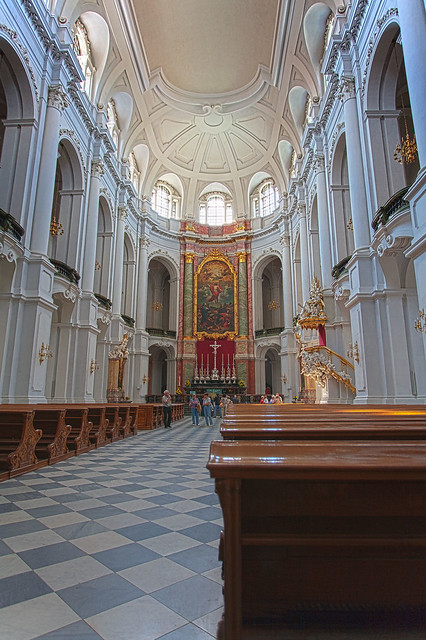 Hofkirche interior |
Leaving the Frauenkirche, we walked along Augustusstraße, with its eye-poppingly magnificent 102-metre-long 1876 mural Fürstenzug, or Procession of the Princes, painted on to 24,000 Meissen porcelain tiles and mounted on the external wall of the old royal stables. This led back to Schlossplatz and the Hofkirche, Dresden's major Catholic church, which we took a few minutes to visit. The interior was mostly white, being still under restoration, but the altar area had been fully restored and painted, giving a small glimpse of what the interior should look like once fully restored.
 Armour in the Rüstkammer |
Then we went to the final museums in the Zwinger - first the Rüstkammer, a single long gallery of antique weapons and armour, including many swords, pole arms, axes, flintlocks, suits of armour, and other assorted military nasties. It was fairly stunning, not only in terms of the artisanship and decoration of some of the pieces, but also to consider that people actually used to have a go at one another, swinging full force with some of the ghastly bladed and spiked horrors we saw.
The next museum was the Gemäldegalerie Altes Meister - across the northern entrance gate from the Rüstkammer - a collection of important artwork, mostly Renaissance era, but some slightly older, including a couple of Botticellis, and some more modern. There were some huge tapestries depicting biblical scenes in the first room, then some stunning panoramic scenes of Dresden by Canaletto, better known for his depictions of Venice. There were a bunch of Reubens, Titians, and van Dyckes amidst collections by various Dutch, French, and Italian masters. In one room we saw a woman working on doing some restoration work to a huge painting of a fat guy riding an even fatter horse which was rearing up on two legs. Rather than being hidden away in a back room somewhere, she was working out in the open, in an area of the room merely roped off from the public. She had magnifying glasses on and was doing something intricate with tiny brushes to a corner of the huge canvas. We spent some time navigating thr four floors of the museum and reached our final gallery after a mazelike path through the collection, only to find the very last painting we looked at was instantly, jaw-droppingly recognisable: Raphael's Sistine Madonna, with its iconic two cherubs at the bottom of the frame. I hadn't even realised this work was housed in Dresden. The cool thing was, with my photography permit, I could take photos of it (and a bunch of the other works which I'd found interesting). I wish all museums were so friendly.
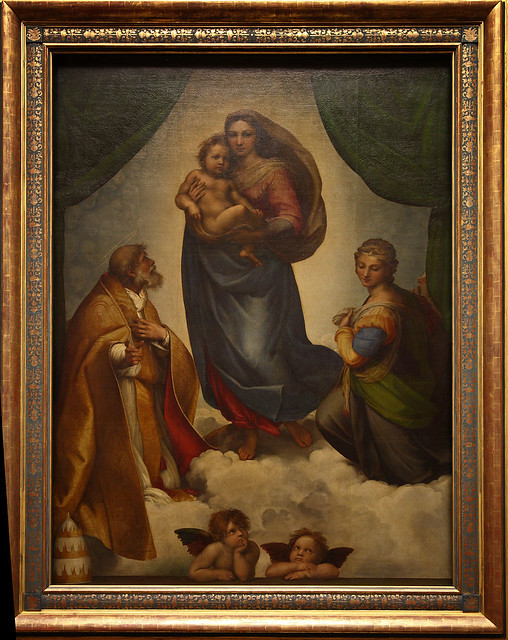 Sistine Madonna in the Gemäldegalerie Altes Meister |
We took a pretzel break, sitting outside in the shade of the Zwinger buildings on a fountain. Then we crossed the street and entered the Schloss to see the Grünes Gewölbe, a collection of precious and bejewelled items and trinkets. It turns out there is a Historisches Grünes Gewölbe and a Neues Grünes Gewölbe, which are separate collections and require separate tickets. Our Tagskarte got us into the Neues, but a helpful guide told us that tickets to the Historisches collection was sold out for the day. They only sold 300 tickets a day for and people queued up from 07:00 to buy them when they go on sale at 10:00!! Boggled, we resigned ourselves to a secondary collection, but some of the stuff in the Neues Grünes Gewölbe was by no means new, mostly dating from 1700 or so.
There were carved ivory, ornamental cups of stone, crystal, nautilus shell, silver, and gold, all decorated intricately in precious metals and jewels. We hurried through a bit to make sure we finished by the 18:00 closing time. We raced to the end by about 10 minutes to, only to discover our second amazing find of the day, as the very last object in the museum: the stunning 41 carat Green Diamond, the largest green-tinted diamond in the world, set in its surrounding of about 150 other white diamonds, as a brooch. The Green Diamond was teardrop shaped, about a centimetre wide and 1.5 cm high, pale apple green in colour and sparkling amazingly in the light. The information plaque indicated that it had cost the King of Saxony some 400,000 thaler to buy it, compared to the 288,000 thaler it had cost to build the original Frauenkirche. This diamond in front of us was worth significantly more than the entire cathedral we had been gobsmacked by earlier in the afternoon!
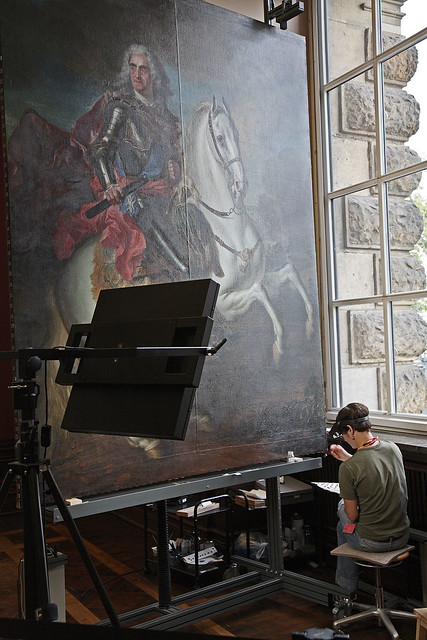 Worker restoring a painting in the Gemäldegalerie Altes Meister |
After leaving the Schloss we meandered back to our hotel, taking a route past the Kreuzkirche. Unfortunately it had closed at 17:30, so all we could do was walk around its impressive bulk, mostly of original blackened stone, with only a few new reconstructed blocks scattered here and there on the facade.
On our way through the station, Michelle was attracted by a buffet-style restaurant we'd seen earlier - Restaurant Marché. We wandered in and discovered it was more like a cafeteria, where you fill plates with food and then pay for it. For €15.20, the result was one of our cheaper sit-down meals of the trip so far. Michelle filled a plate with roast potatoes covered with seeds and cumin, I grabbed a hefty chunk of grilled fish covered in onions and some cheese, and topped up the plate with sides of champignons and fried apple chunks with onions(!). Michelle also grabbed a small bowl of fruit salad and a freshly made strawberry/orange/banana drink. When we went to pay, the woman at the cash register said we'd be paying for the plate full of potatoes and suggested we go add more to it, including stuff from the other vegetables on offer. So Michelle added some cucumber, mushroom, and apple and onion(!) salads. There was also some slices of something white and chunky and sort of watery, which neither of us could identify. Filled up, we headed back to Hotel Kipping for an early night, to rest up for the early start the next day.
[ < < previous | index | next >> ]